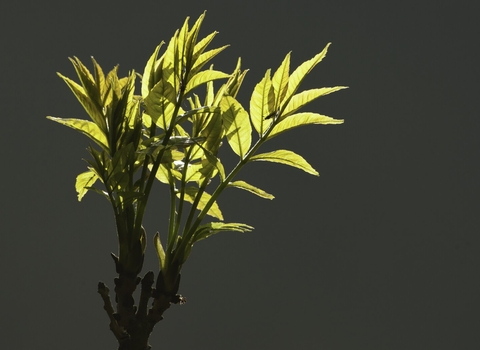The knock-on effect of ash dieback on wildlife could be huge, so what are we doing in Gloucestershire to tackle this threat?
Ash is present in most of the wooded nature reserves we care for, but is particularly prevalent in Lower Woods, Siccaridge Wood, Midger Wood and at Snows Farm. Sadly, dieback has been recorded at all of these reserves and has caused extensive damage, killing numerous trees.
At present there is no way to eradicate this disease and there is little that can be done to prevent its spread, but there are some trees that are less susceptible. Investigating this natural resistance could be the best way to secure the future of the UK's ash trees.
Monitoring infected trees
GWT's Land Management team and volunteers are crucial to keeping an eye on the health of ash trees and Gloucestershire's forests at large. Any trees that are showing symptoms are carefully monitored and assessed for any dangers they might pose.
Felling infected trees that could be dangerous to visitors
Ash dieback causes trees to slowly die, drop limbs, collapse or fall. In places where infected trees grow beside roads and footpaths, they are likely to pose a threat to public safety.
As a result, in some cases infected ash trees will be removed for the safety of site users and to help control the spread of the disease. In these cases, ecological surveys are important to check for the presence of protected species such as badgers and dormice, enabling the appropriate mitigation to be undertaken.
Identifying trees that seem to be resistant and trying to encourage natural regeneration from them
Gloucestershire Wildlife Trust is so concerned about the situation that its staff and volunteers are working to grow replacements. At the new tree nursery at Lower Woods Nature Reserve, oak tree saplings are being grown from acorns collected in the woods. When the saplings are around 48 months old they will be planted in the woods to help fill the gaps resulting from ash tree losses. Other species of trees will also be raised here: hazel, hornbeam, beech and even a few walnut trees. Wild service and hawthorn will also be raised, but these are much more difficult to grow from seed than oak trees and require specialist knowledge.
The nursery has been built by staff and volunteers, including a potting shed made entirely using timber harvested from the woodland.
Allowing deadwood to remain and open habitats to be created
Dead and decaying wood can have negative connotations, with rotting logs or broken branches being seen as dangerous or the woodland is unhealthy. In fact, the risks to people posed by decaying wood are usually small, yet the value to ecosystem health is enormous.
Felled or dead ash trees create a new open space in the woodlands, where different plants colonise and encourages biodiversity and age diversity.
Where appropriate, we allow deadwood to remain and new open habitats to be created within woodlands, as ash trees die or are felled.
Deadwood is an important habitat, with thousands of species from invertebrates and fungi to birds and mammals.
Continue to look at potential species that could be suitable replacements
While there is no one tree that can replace ash, research by a number of different organisations in this area is ongoing.
What you can do to help
Biosecurity is important to help manage the spread of the disease. Simple steps such as washing your footwear before and after walking in woodland, sticking to footpaths and washing bike and car tyres can all help reduce the risk of spores being spread.
Couldn’t find what you’re looking for? You can contact us at info@gloucestershirewildlifetrust.co.uk.

